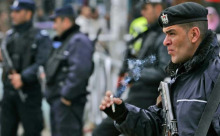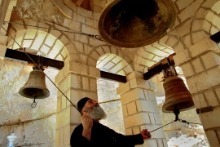Matt Rees's Blog - Posts Tagged "judean-desert"
Inventing the Palestinian detective
 The dead man's mother raged and wept as she told me how she’d discovered her son’s body, in the cabbage patch outside her home. She’d gone down on her knees, she said, touched his blood and wiped her fingers on her face, calling out that God is most great.
The dead man's mother raged and wept as she told me how she’d discovered her son’s body, in the cabbage patch outside her home. She’d gone down on her knees, she said, touched his blood and wiped her fingers on her face, calling out that God is most great.As the winter wind came cold off the Judean Desert, I watched her tears and thought: “I have to write a novel about this.”
Forgive me if that sounds callous, but I’m a writer. Or, I should say, that’s the moment when I became a writer.
I was Time Magazine’s Jerusalem bureau chief, covering the violence of the Palestinian intifada, when I went to that bereaved mother in her village on the edge of Bethlehem in 2002. I had always written fiction, but only published a few short stories. In the midst of the despair that engulfed Israelis and Palestinians, I found the very thing that could make me happy – the material for my series of Palestinian crime novels.
The killing of that woman’s son as he crept home in the dark was the basis for the opening death in my first novel “The Collaborator of Bethlehem.” The book won a Crime Writers Association Dagger. Since then I’ve published two more crime novels set in the Palestinian towns.
They’re a response to the emotional questions that, as a journalist, I was never able to answer. Strangely, fiction proves to be a better way to understand extreme events than journalism.
Since the first time I set foot in the West Bank in 1996, I had grown disillusioned with the ability of journalism to convey the depth of what I learned about the Palestinians. Back then, I visited the family of a Nablus man tortured to death in one of Yasser Arafat’s jails. The news article I wrote was a good one, uncovering the internal Palestinian violence so often overshadowed by the more spectacular conflict with Israel. But my impressions were much deeper.
I was struck by the candor and dignity with which the dead youth’s family spoke to me; the sheer alien nature of the place thrilled me. At the entrance to the family’s house in the casbah, an old oil drum held black flags and palm fronds, symbols of Islamic mourning. Men sat around smoking under a dark awning. I felt a powerful sense of adventure, as though I had uncovered an unknown culture.
The lawlessness of Palestinian life also gave me great characters for my fictionalized good guys. But also the villains. Unfortunately there are many Palestinians who have strong motivations to kill each other. I’ve spent a lot of time over the years with some of these men, trying to learn why they take the path of violence—time that has led to a deeper characterization of the villains in my books.
With my new novel, “The Fourth Assassin,” I brought my sleuth Omar Yussef to New York because I wanted him to confront the most important issue of the last decade – an issue which is crystallized in its most horrifically concrete form in the city of 9/11.
It’s a natural progression for a series that began in the cabbage patch near Bethlehem. When I stood there, it was seven months after the attacks on New York and Washington. The questions posed to anyone thinking about the Middle East had just become so much more complex. Too complex and emotional for journalism to encompass them and, all these years later, for politicians, too.
Whether it’s a single sniper’s bullet cutting through the chest of a man outside his mother’s house or a jetliner bursting through a 110-story building, my novels are aimed at the most explosive points in our recent history. That’s why I simply had to write them.
(I posted this on a joint International Crime Authors blog I write with three other writers. Check it out.)
Published on February 24, 2010 22:49
•
Tags:
9-11, assassination, bethlehem, blog, brooklyn, crime-fiction, journalism, judean-desert, middle-east, new-york, omar-yussef, sniper, the-collaborator-of-bethlehem, the-fourth-assassin, time-magazine, united-nations, washington, west-bank, yasser-arafat
New West Bank road to peace?
 ST. GEORGE’S MONASTERY, West Bank — Gathered in the chapel of this outpost in the Judean Desert last week, the Orthodox priests chanted “Lord, have mercy” in Greek, in a service of blessing for a new road that makes the venerable building accessible to the growing number of tourists willing to dare a visit to the troubled Holy Land.
ST. GEORGE’S MONASTERY, West Bank — Gathered in the chapel of this outpost in the Judean Desert last week, the Orthodox priests chanted “Lord, have mercy” in Greek, in a service of blessing for a new road that makes the venerable building accessible to the growing number of tourists willing to dare a visit to the troubled Holy Land.As far as the Palestinian Authority is concerned, the priests may as well have been speaking, well, Greek. Because the road was built by Israel over land the Palestinians consider their own, officials in Ramallah condemned the priests’ participation in the road’s inauguration ceremony.
Palestinian Prime Minister Salam Fayyad “expressed surprise” that the Orthodox priests joined the director-general of the Israeli Tourism Ministry Tuesday at the monastery, which clings to a cliff side over Wadi Qelt, a deep canyon running down to the Jordan Valley. Another Palestinian minister said the monks’ presence “gave a deceiving impression” about the status of the land around St. George’s.
Like other stretches on the rocky road that still clings to the misnomer “peace process,” the Palestinian protest will fade like a mirage in the desert surrounding St. George’s. More important in the end is the (literally) concrete path laid out for pilgrims to visit one of the most important and most beguilingly beautiful sacred sites in the Holy Land.
Archbishop Aristarchos, the secretary of the Greek Orthodox Patriarchate in Jerusalem and the leader of the brief prayer service, was diplomatic in his comments, when asked about Palestinian complaints over the road.
“This is a monastery of prayer for peace in our region, for peace in the Holy Land,” Aristarchos said. “The road brings full access for pilgrims who are messengers of peace to the Holy Land.”
The $500,000 road cuts over from the main Jerusalem-Jericho highway in front of the entrance to an Israeli settlement. It snakes around dusty dunes and dry wadis. To the east, the view is hazy down over the Jordan Valley to the mountains rising in the Hashemite Kingdom. After a 10-minute drive, visitors arrive at a parking lot.
Read the rest of this post on my blog
Published on December 13, 2010 08:16
•
Tags:
arabs, bethlehem, christians, churches, greek-orthodox, holy-land, israel, israeli-tourism-ministry, israelis, jericho, jerusalem, jews, jordan-valley, judean-desert, nazareth, palestine, palestinians, salam-fayyad, st-george-s-monastery, wadi-qelt, west-bank



